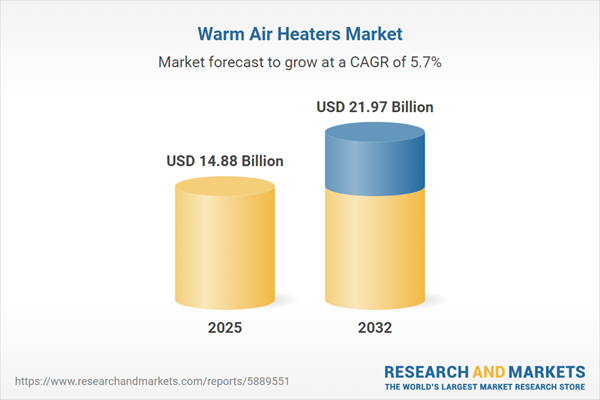Speak directly to the analyst to clarify any post sales queries you may have.
Senior executives across facilities and enterprise management are recognizing the need for modernized, flexible heating solutions that align with evolving sustainability and compliance requirements. The warm air heaters market now offers advanced technologies and procurement approaches, enabling organizations to meet operational challenges while supporting their environmental and regulatory goals.
Market Snapshot: Warm Air Heaters Market Growth
The warm air heaters market is positioned for steady advancement, with global valuation forecast to reach USD 14.05 billion in 2024 and projected to rise to USD 14.88 billion by 2025. This represents a compound annual growth rate (CAGR) of 5.74%. Looking further, the market opportunity is anticipated to exceed USD 21.9 billion by 2032. Key drivers include heightened demand from commercial and industrial sectors seeking efficient heating systems that reinforce sustainability strategies and meet compliance thresholds. Decision-makers are targeting infrastructure investments that integrate with facility systems, optimizing resource management, procurement workflows, and long-term sustainability.
Scope & Segmentation of the Warm Air Heaters Market
- Fuel Type: Electric warm air heaters are favored in grid-connected settings for ease of integration; gas-fired units offer rapid deployment options for enterprises requiring flexibility; oil-fired systems address needs in locations with unique supply or infrastructure constraints.
- End User: The commercial segment covers sectors like healthcare, hospitality, retail, warehousing, and multi-residential properties. Industrial applications span automotive, chemical processing, and food production, where adherence to regulatory standards is paramount.
- Mounting: Ceiling-mounted, wall-mounted, and floor-standing options enable organizations to tailor installations to both new developments and retrofit projects, maximizing space and operational efficiency.
- Distribution Channel: Procurement occurs through direct sales, retail partners, and digital platforms, giving enterprises supply flexibility and the ability to respond quickly to shifting operational requirements.
- Capacity Range: Compact units under 50 kW are suitable for smaller or space-restricted environments. Mid-capacity heaters (50–100 kW) serve most commercial applications, while high-capacity systems above 100 kW meet demanding industrial needs.
- Region: Adoption patterns are shaped by local climate, the state of utility infrastructure, and regulatory context across the Americas, Europe, Middle East and Africa, and Asia-Pacific, affecting technology choices and integration pace.
- Key Companies: Industry participants include Carrier Global Corporation, Daikin Industries, Trane Technologies, Johnson Controls International, Emerson Electric, Robert Bosch GmbH, Modine Manufacturing, Voltas Limited, Nortek Air Solutions, and Lennox International, each offering portfolios suited to enterprise modernization and procurement strategies.
Key Takeaways for Senior Decision-Makers
- Smart heating controls can be integrated with facility management platforms, providing real-time monitoring and supporting proactive maintenance for multiple sites.
- Modular heater designs deliver infrastructure scalability, making it easier for enterprises to adapt systems to shifting compliance and operational demands.
- Leveraging a range of procurement channels—including digital sourcing—improves responsiveness and ensures supply resilience as regulations or market conditions shift.
- Selecting heater capacity and integrated features tailored to the operational context heightens energy efficiency and ensures alignment with compliance priorities.
- Factoring in local climate, relevant legislation, and utility reliability strengthens equipment selection strategies and helps balance cost with risk management.
- Working closely with established technology vendors can accelerate deployments, limit downtime, and simplify adaptation to organizational or regulatory evolution.
Tariff Impact on Supply Chains and Pricing Dynamics
Recent US tariffs on imported components are prompting enterprises to diversify sourcing and emphasize regional suppliers. This shift helps organizations maintain stable access to critical heating technologies, manage exposure to policy shifts, and reduce supply chain disruptions for essential operations.
Methodology & Data Sources
This market analysis draws on interviews with senior executives, comprehensive review of regulatory changes, broad secondary research, and advanced statistical modeling to deliver actionable insights for enterprise procurement and facility management decisions.
Why This Report Matters for the Warm Air Heaters Market
- Segmented findings guide leaders in aligning procurement and deployment strategies with sustainability, compliance, and operational objectives across enterprise facilities.
- Continuous monitoring of the regulatory landscape supports proactive risk mitigation and positions organizations to capitalize on compliance-driven opportunities for growth.
- Data-driven insights empower more confident budgeting and technology investments amid diverse regulatory and geographic contexts.
Conclusion
By investing in adaptable, compliant heating infrastructure, organizations build flexibility, enhance operational continuity, and position themselves to thrive as market and regulatory expectations evolve.
Additional Product Information:
- Purchase of this report includes 1 year online access with quarterly updates.
- This report can be updated on request. Please contact our Customer Experience team using the Ask a Question widget on our website.
Table of Contents
3. Executive Summary
4. Market Overview
7. Cumulative Impact of Artificial Intelligence 2025
Companies Mentioned
The companies profiled in this Warm Air Heaters market report include:- Carrier Global Corporation
- Daikin Industries, Ltd.
- Trane Technologies PLC
- Lennox International Inc.
- Johnson Controls International PLC
- Emerson Electric Co.
- Robert Bosch GmbH
- Modine Manufacturing Company
- Voltas Limited
- Nortek Air Solutions
Table Information
| Report Attribute | Details |
|---|---|
| No. of Pages | 192 |
| Published | November 2025 |
| Forecast Period | 2025 - 2032 |
| Estimated Market Value ( USD | $ 14.88 Billion |
| Forecasted Market Value ( USD | $ 21.97 Billion |
| Compound Annual Growth Rate | 5.7% |
| Regions Covered | Global |
| No. of Companies Mentioned | 11 |









